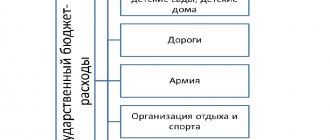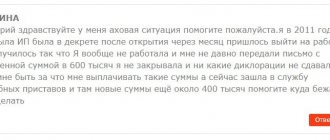Taxes paid by individual entrepreneurs without employees and with employees for 2017
In the Russian Federation, a businessman is given a choice of taxation system.
One of the five existing options is selected depending on the scope of the business, the number of employees and resources.
The amount paid by the individual entrepreneur to the treasury will depend on the selected mode.
Therefore, it is important to know some of the subtleties of paying taxes for individual entrepreneurs for 2017 without employees and with employees in different variations of taxation.
Payments for individual entrepreneurs without employees
For individual entrepreneurs who operate without hiring employees, there are basic and special taxation regimes:
- The STS (main taxation system) is automatically assigned to the individual entrepreneur upon registration. If the individual entrepreneur prefers another system, it is necessary to complete and submit an application for the transition within a certain period. The OSN consists of several taxes, and as a result of their addition, a rather large amount is obtained:
Property tax for individuals At 13% In the amount of 10% - 18% Unfixed - The simplified taxation system (STS) can sometimes significantly reduce the expenses of individual entrepreneurs.
- Here, much depends on the success of the development of the enterprise and the choice of the entrepreneur: 1) Income at a rate of 6%. 2) Profit at a rate of 15%.
- Imputed income tax (UTI) is popular among individual entrepreneurs without employees. It simplifies reporting and tax pressure. Payment is 15% of income;
- The patent system completely eliminates the payment of tax; it is necessary to pay 6 percent of the basic income of an individual entrepreneur for a patent;
- The Unified Agricultural Tax (USAT) is valid exclusively for production related to agricultural products. The organization pays 6% of profits to the treasury.
All special modes are designed for specific types of activities.
In some situations, using one of the modes may be illegal.
Taxes for individual entrepreneurs with employees
An entrepreneur who attracts employees for further employment is an employer.
In addition to employee salaries, additional contributions for each employee are added to its expenses:
- Personal income tax persons (NDFS) is 13% of the employee’s salary, deducted from this amount.
- Insurance contributions to extra-budgetary funds.
| Pension Fund of Russia (PFR) | Federal Compulsory Medical Insurance Fund (FFOMS) | Social Fund insurance of the Russian Federation (FSS) |
| 22% of salary | 5,1% | 2,9% |
An individual entrepreneur with employees in 2020 can legally save on payments and deductions.
There is a whole list of categories of payers who have reduced contribution rates.
For example, individual entrepreneurs engaged in the production of toys and food.
Tax reporting of individual entrepreneurs using the simplified tax system
A simplified taxation system involves replacing several taxes with one, resulting in simplified tax accounting. Such reporting by individual entrepreneurs to the tax authorities on the simplified tax system includes the calculation of the single tax and declarations on VAT amounts. There are two types of tax calculation under the simplified tax system:
- for the amount of income a – the rate is set at 6%;
- according to the results of the calculation of “income-expenses” at a rate of no more than 15%.
Accordingly, in a simplified manner, the tax is calculated by simply subtracting the amount of expenses accepted for accounting from the gross income.
The entrepreneur is given 4 months to prepare and submit the annual declaration (i.e., the deadline is the same as for personal income tax - until April 30). If the deadline for submitting the document is not met, the entrepreneur will be subject to a fine of 5 percent of the tax amount for each month.
A simplified tax return for individual entrepreneurs can be filed if there was no income during the reporting period or the work is seasonal. Thus, filing tax reports for individual entrepreneurs using the simplified tax system in 2020 includes a quarterly VAT return and an annual single tax report.
How are taxes and contributions of individual entrepreneurs calculated in the current year 2020?
An individual entrepreneur is simply an individual with the right to entrepreneurial activity.
Unlike legal entities, taxes for individual entrepreneurs are much simpler and easier.
But, nevertheless, even in this case, it takes time to figure out what to pay when and how to calculate.
Mandatory insurance contributions to the Pension Fund (pension tax)
If the income of an individual entrepreneur for 2020 is within 300 thousand rubles, then the formula for calculation looks like this:
1 minimum wage * 12 * 26%.
If the amount exceeds 300 thousand rubles, another 1% is imposed on income received above this mark.
The upper limit of the contribution to the Pension Fund is no more than
8 minimum wage * 12 * 26%.
Mandatory insurance contributions to the FFOMS
These contributions this year are unchanged for all individual entrepreneurs regardless of income and amount to 4,590 rubles, they are calculated as follows:
1 minimum wage * 12 * 5.1%.
Individual entrepreneur contributions for employees
A detailed description of the calculation of this contribution has already been discussed above.
It’s easy to calculate: the total amount of this tax is 30% of the money paid to the employee.
Taxes on the simplified tax system
The so-called “simplified” system is very popular among small business owners.
Tax is imposed on either income or income minus the amount of expenses, at the discretion of the entrepreneur.
To calculate the amount to be paid, we multiply the base by the rate, which is:
- “expenses are deducted from income” - 15%;
- “income” - 6%.
In some regions, the rate was reduced from 15% to 5%, and 6% even to 1%.
Local authorities do this in order to attract investment or develop certain types of activities.
Please note that the tax under the simplified regime, as under the general regime, is calculated based on the amount of total income.
Accordingly, if an individual entrepreneur did not work for some time and did not receive income, then this tax does not need to be paid.
Individual entrepreneur taxes for PSN
This mode is designed exclusively for individual entrepreneurs.
It is necessary to find out for which types of activities a patent can be taken out from the territorial inspectorates, since in each region there are amendments and changes.
A patent is valid only for the subject where it was originally issued, with the exception of cargo transportation. Under the patent regime, the number of employees cannot exceed fifteen people, and the maximum annual income can be no more than 60 million rubles.
A patent can be taken out for a period of 1 month to 12 months.
To find out the cost of a patent for a year, you need to know the potential income for a year in a given field of activity, which is multiplied by 6%.
A patent valid for a maximum of 6 months must be paid within 25 days after it becomes effective.
If its duration is more than six months, payment is made in the following order: one third is paid within 25 days, the remaining part no later than 30 days before the end of its validity.
Taxes on UTII
The payment applies to certain areas of activity.
Regionally, their list may not only be reduced, but such a regime may be completely prohibited.
The tax is calculated as follows:
BD * FP * K1 * K2 * 15%,
Where:
- K1 – deflator coefficient. The Ministry of Economic Development of the Russian Federation sets this indicator annually.
- K2 – reduction coefficient, set annually by regional structures (ranges from 0.005 to 1).
- DB – basic monthly income per physical unit. indicator.
- FP is a physical indicator, which can be the number of workers, retail facilities or the area of the trading floor and many other options.
The payment is mainly calculated for 3 months, that is, per quarter.
It is paid until the 25th day of the month following the quarter.
There are restrictions on the number of employees; their number should not exceed 100 people.
Tax for individual entrepreneurs on the Unified Agricultural Tax
The payment is intended for those who produce agricultural products.
The tax is calculated according to the principle:
“total income minus expenses”, the constant tax rate is 6%.
If an individual entrepreneur already operates using a general or simplified taxation system, it is possible to switch to the unified agricultural tax only from the beginning of next year.
The importance of choosing a system for paying taxes
When starting a business, an individual entrepreneur has a choice of whether to open it with or without employees. You can open an individual entrepreneur as a “self-employed population” and, based on this, have a more convenient and profitable scheme for paying tax contributions. A business entity can, for convenience, combine tax regimes in any combination, but must maintain separate reporting and pay tax contributions based on the requirements of each individual system.
Regardless of which deposit model he chooses, whether he will make a profit or not, it is necessary to pay certain funds to the Pension Fund. Insurance amounts begin to be calculated as soon as the individual entrepreneur is registered with the Federal Tax Service. The amount of insurance payments is rechecked annually, focusing on the minimum wage approved this year.
Individual entrepreneurs have the opportunity to voluntarily register with the Social Insurance Fund and make insurance payments. Who benefits from this? Entrepreneurs who are exposed to frequent illnesses or who are planning to go on maternity leave in the coming year. By making payments to the Social Insurance Fund, a business entity can confidently count on sick leave and maternity benefits.
On video: Self-employment in Russia
Combination of tax regimes - an opportunity to reduce taxes for individual entrepreneurs
For those who know how and love to save, there is another great opportunity - to combine some tax regimes.
Having calculated the approximate tax burden, you can work in one mode for one type of activity, and choose a more optimal option for another activity.
If activities are carried out at different facilities, it is possible to combine modes of one type.
Combination options: PSN and simplified tax system; UTII and PSN; Unified agricultural tax and UTII; UTII and PSN; UTII and simplified tax system
Incompatible: simplified taxation system and OSN; Unified agricultural tax and simplified tax system.
It is impossible to say unequivocally how to combine taxation regimes correctly and profitably.
Since the amounts must be calculated for each region and type of activity individually.
But using these principles, it is definitely possible to reduce payments without breaking the law.
Amounts of additional contributions and payments that individual entrepreneurs pay from themselves in 2020
In addition to all the listed taxes, the responsibilities of individual entrepreneurs include paying property taxes:
- Transport tax (imposed on the entrepreneur’s personal transport)
- Property tax (apartment, dacha, house, etc.)
- Land tax (plot of land)
- Water tax (well, well)
Since 2020, a new accrual system has come into force: based on cadastral value.
Before this, the inventory system worked.
Under the new system, the amount of taxes that must be paid to the treasury has increased significantly. The tax rate for residential premises in Moscow is:
- for premises with a cadastral value of up to 10 million rubles – 0.1%;
- from 10,000,000 to 20,000,000 rubles. – 0.15%;
- from 20,000,000 to 50,000,000 rubles. –0.2%;
- from 50,000,000 to 300,000,000 rub. – 0.3%.
For objects costing over 300,000,000 rubles, the calculation rate is 2%.
Properties whose construction has not yet been completed are also subject to taxes of 0.3%.
The cadastral value is determined by order by an independent expert; the information is stored in the state real estate cadastre.
Revaluation is carried out no less than once every 5 years and no more often than once every 2 years, in some regions every 3 years.
There are benefits for certain categories of citizens:
- Pensioners
- Combatants
- Disabled people
- Military contractors
- Order bearers
- Chernobyl victims
- Some categories of state employees
Since 2020, the law on the tax on the sale of apartments has been changed; the tax-free period of ownership of an object has become 5 years, instead of 3.
When selling real estate, the owner will have to pay 13% personal income tax.
There are also additional industry taxes, they depend on what the entrepreneur’s activities are related to:
- Mineral tax Payment is paid if the entrepreneur’s field of activity is directly related to the extraction of mineral resources. It is collected in an amount depending on the location of the site and its area.
- Hunting Payment is collected from persons who have a license to use elements of the animal world
- Fishing Charged from persons with a license to use water bodies
- Production of printed products
- Conducting lotteries
Additional taxes, fees and payments are paid under any taxation system chosen by the entrepreneur.
IP 2020: changes
Deflator coefficients in 2020
Deflator coefficients for 2020 were approved by Order of the Ministry of Economic Development of Russia dated November 3, 2016 No. 698.
The deflator coefficient for UTII will remain at the same level - 1.798.
Minimum wage in 2020
From July 1, 2020, the minimum wage will increase by 300 rubles. (by 4%) and will amount to 7800 rubles.
Recently it also became known that by the fall of 2020 a bill could be developed to gradually raise the minimum wage to the subsistence level. The first deputy head of the United Russia faction in the State Duma, Andrei Isaev, announced that for this purpose a working group would be created, which would include the Minister of Finance, the Minister of Labor and Social Protection, deputies and senators.
The last time the minimum wage increased was July 1, 2020. Then it grew by almost 21% - to 7,500 rubles.
UTII in 2020
The most important change regarding this preferential tax system is the extension period for its validity. Previously, it was said about the abolition of UTII from January 1, 2020, which supposedly should have led to an increase in the interest of entrepreneurs in the patent taxation system. It was assumed that the patent system would replace imputation. However, on June 2, 2020, the president signed a law extending the validity of UTII until January 1, 2021.
Another important change: from January 1, 2020, according to the new edition of paragraph 2 of Art. 346.32 of the Tax Code of the Russian Federation, individual entrepreneurs on UTII receive the right to reduce UTII by insurance premiums for themselves. In the meantime, an entrepreneur with employees deducts from UTII only contributions from their salaries. It is important that next year for individual entrepreneurs with employees the limit will remain - UTII cannot be reduced by more than 50%.
New service codes for UTII, simplified tax system and PSN
From 2020, a modified list of codes for household services will be in effect for users of the preferential taxation systems of the simplified tax system, UTII and PSN. The corresponding Order of the Government of the Russian Federation dated November 24, 2016 N 2496-r was published. The document contains a list of codes for types of economic activities related to household services (contains codes according to the OKVED2 classifier), and a list of service codes related to household services (contains codes according to OKPD2).
Previously, to determine the types of activities that are available to entrepreneurs on preferential tax systems, it was necessary to use the All-Russian Classifier of Services to the Population (OK 002-93). From January 1, 2020, it ceases to be valid; a transition will be made to the new All-Russian classifier “OK 029-2014 (NACE Rev. 2)”.
Patent tax system
The amount of payment for using a patent depends on local authorities, so individual entrepreneurs in the regions must be well versed in local legislation.
As for Moscow, Moscow City Law No. 139 dated November 23, 2016 “On amendments to certain laws of the city of Moscow in the field of taxation” from 2020 gives entrepreneurs the opportunity to acquire patents for selling goods through vending machines. In addition, the authorities are trying to make the use of this tax system convenient: for taxi drivers (the link to a specific car has been removed), leasing of non-residential premises (additional differentiation of the cost of a patent has been introduced).
Paying taxes for third parties
If an entrepreneur has a blocked account or does not have money, but needs to pay taxes, then from 2020 third parties will be able to do this for him. This opportunity to pay taxes for taxpayers by third parties is provided by Federal Law No. 401-FZ dated November 30, 2016.
Self-employed citizens
Federal Law No. 401-FZ of November 30, 2016 also introduces a two-year tax holiday for self-employed citizens who provide household services to individuals. They are offered the opportunity to voluntarily register with the tax authorities and not pay personal income tax for the next two years. After the tax holiday, self-employed citizens will have to decide whether to stop operating or become an individual entrepreneur.
simplified tax system
Federal Law No. 401-FZ of November 30, 2016 introduced changes in relation to the simplified tax system. From January 1, 2020, new income limits will come into effect.
Firstly, the right to switch to the “simplified system” was given to organizations with an income based on the results of 9 months of the year in which the notification of the transition to the simplified tax system was submitted, not exceeding 112.5 million rubles. (previously - 90 million). Secondly, for taxpayers already using the simplified tax system, the income limit has increased to 150 million rubles. This means that “simplified” has become even more profitable.
Penalty
From 2020, the interest rate on tax payments will double. If an organization has not paid tax before 30 days, the rate will be 1/300, after that it will be 1/150. But the individual entrepreneur still pays 1/300 (Federal Law of November 30, 2016 No. 401-FZ).
Simplification of personnel records for micro-enterprises
On January 1, 2020, Federal Law No. 348-FZ dated July 3, 2016 comes into force, simplifying personnel records for micro-enterprises. It allows such companies to do without local personnel regulations (internal labor regulations, shift schedules, etc.). The government has approved a standard form of an employment contract, in which all these conditions can now be spelled out.
If the employer has ceased to be a small business entity, which is classified as a micro-enterprise, and appropriate changes have been made to the information about it in the Unified Register of Small and Medium-Sized Enterprises, he must complete the necessary personnel documents no later than four months.
Micro-enterprises are not required to enter into standard employment contracts with their employees. The use of this document is assumed at the request of the head of the company.
Increase in fines for violations related to wages
Federal Law No. 272-FZ dated July 3, 2016 increases fines for delays in wages and other payments due to an employee.
For non-payment or incomplete payment on time of wages, other payments made within the framework of labor relations, or setting wages in an amount less than the amount provided for by labor legislation, a fine is provided in the following amounts:
- from 10,000 to 20,000 rub. – for officials (again – from 20,000 to 30,000 rubles).
Possible disqualification for a period of 1 to 3 years
- from 1000 to 5000 rub. – for individual entrepreneurs (repeatedly – from 10,000 to 30,000 rubles)
- from 30,000 to 50,000 rub. – for legal entities (again – from 50,000 to 100,000 rubles)
You should also pay attention to the fact that from December 1, 2020, Decree of the Government of the Russian Federation dated November 18, 2016 No. 1213 expands the list of grounds for an unscheduled inspection within the framework of state supervision in the field of labor (if the inspectorate received a message about the employer’s violation of the terms of payment of wages and other payments due to employees, or setting wages below the amount provided for by labor legislation.
Online cash registers from February 1, 2020
On July 15, 2020, Federal Law No. 290-FZ came into force, which amended Law No. 54-FZ “On the use of cash register equipment.”
If, from July 15, 2020, there is a voluntary transition to online cash registers, then from February 1, 2020, registration of cash registers will take place only according to the new procedure, and from July 1, 2020, the old procedure ceases to apply. Moreover, from July 1, 2020, the obligation to use online cash registers will appear even for those who were previously exempt from using cash registers (service providers, owners of vending machines, small businesses with a patent and UTII). Details in the article “Online cash registers in 2020: transition order.”
Is an individual entrepreneur obligated to pay something without any activity or employees?
For some reason, beginning entrepreneurs believe that if their enterprises are inactive and do not generate income, then they do not need to pay anything.
According to the law of the Russian Federation, regardless of whether the individual entrepreneur is working or not, insurance premiums are still paid.
In the same way, the entrepreneur must provide the tax service with all required reports.
When the enterprise is not operating, additional payments and contributions for employees are not paid.
As a result, it turns out that the amount of tax on such an enterprise in 2017 will be: 27,990 rubles.
They are paid at the end of the year or, if desired, gradually throughout the year by quarters.
Remember that all taxes and contributions not paid on time are subject to a penalty in the form of penalties, sometimes a very large amount.
And you will be required to repay it along with the main payment.
It is much cheaper and more efficient to pay everything on time!
Individual entrepreneurs
So, first of all, you need to understand why it is possible for an individual entrepreneur to reduce the tax percentage from six to zero. This can be done because Article 346.21 of the Tax Code of the Russian Federation applies in the simplified taxation system.
It reads: “Taxpayers who have chosen income as an object of taxation reduce the amount of tax (advance tax payments) calculated for the tax (reporting) period by the amount...”.
This is achieved through different insurance premiums. It works like this: the taxpayer makes small amounts of insurance contributions throughout the year, and when he submits reports as an individual entrepreneur without employees, he reduces the tax by the amount of these payments.
Calculation of Fixed Contributions for 2020
The procedure for calculating contributions to the Pension Fund in 2020:
- The fixed part of the contributions is paid by December 31 of the reporting year. It is obligatory to pay for all entrepreneurs, regardless of the presence or absence of financial and economic activity, taxation regime and the amount of income received. Fixed contributions to the Pension Fund are calculated using the formula (minimum wage at the beginning of the year x Insurance premium rate (26%) x 12);
- before April 1 of the year following the reporting year, the estimated part of the insurance contributions to the Pension Fund is paid (1% of the amount of income over 300 thousand rubles per year)
In 2020, only fixed payments are paid to the FFOMS. Contributions to the FFOMS from incomes over 300 thousand rubles. are not calculated or paid. Fixed contributions to the FFOMS are calculated using the formula (minimum wage at the beginning of the year x Insurance premium rate (5.1%) x 12)
To calculate insurance premiums for the entire 2020, you need the minimum wage established as of January 1 of the reporting year*. We will calculate the annual amount of contributions based on the amount established on July 1, namely 7,500 rubles.
*P. 1 tbsp. 430 of the Tax Code of the Russian Federation as amended. Federal Law of July 3, 2020 No. 243-FZ.
Small business support in 2017
The Ministry of Economic Development allocates almost 15 billion rubles to support small businesses in Russia; it is quite difficult to implement plans in the conditions of the economic crisis. However, some of these funds have already been allocated in 2020, although some officials believe that 15 billion rubles is too high an amount that the current budget will not support.
The Government also plans to create more flexible conditions next year for providing loans to small businesses. For entrepreneurs, a loan rate of 10-11% per annum will be established.
However, do not forget that the authorities are introducing a new real estate tax; if previously the tax burden fell on owners of premises with an area of more than 2,000 sq.m., now the tax will have to be paid for premises with an area of 1,000 sq.m.
2017 will be marked by many innovations in the tax field; individual entrepreneurs will have to adapt to new realities. Some things will greatly complicate the activities of individual entrepreneurs, but many things will also speed up the development of small businesses in our country, which will improve the business climate and benefit the Russian economy.
Fixed contributions for 2020
* Calculations are based on the minimum wage for 2020 – 7,500 rubles.
| Contribution | Rate | KBC for 2020 | In 1 month | For 1 quarter | In a year |
| Pension Fund (insurance part) | 26% | 18210202140061110160 | 1950-00 | 5850-00 | 23400-00 |
| FFOMS | 5,1% | 18210202103081013160 | 382-50 | 1147-00 | 4590-00 |
| Total: | 2332-50 | 6997-50 | 27990-00 | ||
Calculation of contributions for an incomplete reporting period
If the individual entrepreneur did not work for the full reporting period, the amount of insurance premiums is calculated as the amount:
contributions for fully worked months (minimum wage x PFR rate (or FFOMS) x number of months);
the amount of contributions for an incompletely worked month (minimum wage: number of calendar days in a month x number of days from the date of registration (inclusive) until the end of the month x Rate of the Pension Fund (or FFOMS));
Those. if the entrepreneur was registered on February 10, 2017, the amount of insurance premiums for 2020: to the Pension Fund will be 20,753.57 rubles. (7500 x 26% x 10 months + (7500: 28 x 18) x 26%); in FFOMS - 4070.89 rubles. (7500 x 5.1% x 10 months + (7500: 28 x 18) x 5.1%).
The deadline for paying fixed payments is until December 31 of the year for which contributions are paid, but it is better to pay payments before December 27, due to the fact that in the last days of the year banks may not have time to transfer payments.
Advance payment deadlines
The annual report using the simplified system is submitted only once a year. However, legal norms establish the obligation to calculate and transfer advance tax payments to the budget.
This operation must be performed at the end of each quarter. The Tax Code stipulates the deadlines within which the entrepreneur is obliged to do this - until the 25th day of the month following the previous quarter. The final annual payment is due by April 30 of the year following the reporting year.
When determining the deadline for payment, you must remember that it is subject to the transfer rule. It follows from this that if such a day falls on a weekend or holiday, then it must be shifted forward to the next working day.
You might be interested in:
Form P-4 NZ in statistics: sample filling
In 2020, tax transfers according to the simplified tax system will need to be completed within the following deadlines:
| Period | Payment deadline under simplified tax system |
| For 2020 | 05/03/2018 |
| 1st quarter 2020 | 04/25/2018 |
| 2nd quarter 2020 | 07/25/2018 |
| 3rd quarter 2020 | 25-10-2018 |
| For 2020 | 04/30/2019 |
When transferring the amount of the advance payment or the final tax, you must correctly enter the KBK code in the payment order.
Due to the fact that the simplified system offers two ways to determine the amount of tax - based on income, or to reduce them by the amount of expenses incurred, there are two groups of BCC:
- "Income":
– Tax 182 105 01011011000110
– Peni 182 105 01011012100110
– Fine 182 105 01011013000110
- “Income minus expenses”:
– Tax 182 105 01021011000110
– Peni 182 105 01021012100110
– Fine 18210501021013000110
If an entrepreneur uses the “Income reduced by expenses” system, then in certain cases he may be required to pay a minimum tax. This necessarily arises if a loss is received, or a certain amount of tax is below the minimum level.
Attention! Previously, a separate BCC was in force for the minimum tax. Now it needs to be transferred to the same place where the tax is sent according to the “Income minus expenses” system - 182 105 01021011000110.
Calculation of contributions for incomes over 300 thousand rubles
If the income of an individual entrepreneur for the billing period exceeds 300 thousand rubles, in addition to fixed payments in the amount of 27,990.00 rubles. (PFR + FFOMS), he must transfer to the Pension Fund of the Russian Federation the estimated part of insurance contributions, amounting to 1% of the excess amount*.
* clause 1 art. 430 of the Tax Code of the Russian Federation as amended. Federal Law of July 3, 2020 No. 243-FZ.
The law provides for a limitation on the amount of insurance contributions to the Pension Fund. They cannot exceed the product of eight times the minimum wage at the beginning of the year and the Pension Fund tariff, increased by 12 times. Those. for 2020, the maximum amount of contributions to the Pension Fund is 187,200 rubles. (7500 x 8 x 26% x 12)
Important! For entrepreneurs using the simplified tax system of 15% (income minus expenses), expenses are not taken into account when calculating insurance premiums.
Income calculation
*clause 9 of Art. 430 of the Tax Code of the Russian Federation as amended. Federal Law of July 3, 2020 No. 243-FZ.
| Tax regime | Income | Where do we get it from? |
| OSNO (income from business activities) | Income subject to personal income tax, reduced by the amount of professional tax deductions. Calculated in accordance with Art. 227 of the Tax Code of the Russian Federation and the letter of the Federal Tax Service of Russia dated February 10, 2017 No. BS-4-11/ [email protected] .” | Declaration 3-NDFL; clause 3.1. and clause 3.2. Sheet B |
| simplified tax system regardless of the chosen taxation option (6% or 15%) | Income subject to the Single Tax. Calculated in accordance with Article 346.15 of the Tax Code of the Russian Federation | Result of column 4 of the Income and Expense Book |
| Patent system | Potential income. Calculated in accordance with Article 346.47 and 346.51 of the Tax Code of the Russian Federation | Income from which the cost of the patent is calculated |
| UTII | Imputed income. Calculated in accordance with Article 346.29 of the Tax Code of the Russian Federation | Section 2 p.100 Declaration on UTII. If there are several Sections 2, all amounts on line 100 are added together |
| Unified agricultural tax | Income subject to Unified Agricultural Tax. Calculated in accordance with clause 1 of Article 346.5 of the Tax Code of the Russian Federation | Result of column 4 of the Income and Expense Book |
If an individual entrepreneur applies more than one tax regime, taxable income from activities is summed up.
Payment deadline: insurance premiums in the amount of 1% of the amount of income over 300 thousand rubles must be transferred to the budget no later than April 1 of the year following the expired billing period.
Attention entrepreneurs! From 2020, to pay a contribution on income exceeding 300 thousand rubles. The following BCCs are used:
- 182 1 0210 160 for contributions from income for 2020 and later periods;
- 182 1 0200 160 for contributions from income for 2020 and earlier periods.
Example: The income of an individual entrepreneur born in 1970 amounted to 2,400,000 thousand rubles in 2020. The amount of insurance contributions to the Pension Fund will be: fixed part 23,400.00 rubles. + individual part (2,400,000 – 300,000) x 1% = 21,000 rub. Total: RUB 44,400.00 In FFOMS, regardless of the amount of income, we pay a fixed payment of 4590.00 rubles.
Deadlines for filing a declaration under the simplified tax system for individual entrepreneurs
Reporting for an LLC using the simplified tax system and a declaration using the simplified tax system for the tax system do not have any special differences, except for a few lines when filling out. They also have the same deadlines for filing with the Federal Tax Service, so everything is easy to check and find out.
The only difference is that for individual entrepreneurs there are fewer tax items, which means it is easier to submit reports. Therefore, there is no need to worry too much about the number of deadlines.
Examples of calculations of Advance payments for the 1st quarter of 2020
Individual entrepreneur without employees, “income” taxation system
The income of the individual entrepreneur for the 1st quarter amounted to 330,000.00 rubles. Fixed contributions of the Pension Fund and the Federal Compulsory Medical Insurance Fund were paid for the 1st quarter = 6998.00
| Description | Calculations | Result | |
| 1 | We consider the tax base (income) as a cumulative total for the 1st quarter | RUB 330,000 | RUB 330,000 |
| 2 | We calculate the initial tax (tax base x tax rate) | RUB 330,000 x 6% | RUB 19,800 |
| 3 | We consider insurance premiums as an accrual total for the 1st quarter | RUB 6,998 | RUB 6,998 |
| 4 | We determine the deduction (equal to insurance contributions that do not exceed the primary tax) | RUB 6,998 (contributions) < RUB 19,800 (primary tax) | RUB 6,998 |
| 5 | We calculate the advance payment for the 1st quarter (period tax - deduction) | RUB 19,800 — RUB 6,998 | RUB 12,802 |
| The total advance payment for the 1st quarter is equal to: | RUB 12,802 | ||
| Payment deadline: | 25th of April | ||
| KBK: | 18210501011011000110 | ||
Individual entrepreneur with employees, “income” taxation system
The income of the individual entrepreneur for the 1st quarter amounted to 330,000.00 rubles. Fixed contributions of the Pension Fund and the Federal Compulsory Medical Insurance Fund were paid for the 1st quarter = 6998.00
| Description | Calculations | Result | |
| 1 | We consider the tax base (income) as a cumulative total for the 1st quarter | RUB 330,000 | RUB 330,000 |
| 2 | We calculate the initial tax (tax base x tax rate) | RUB 330,000 x 6% | RUB 19,800 |
| 3 | We consider insurance premiums as an accrual total for the 1st quarter | RUB 6,998 | RUB 6,998 |
| 4 | We determine the deduction (equal to insurance contributions that do not exceed the primary tax / 2) | RUB 6,998 (contributions) < RUB 9,900 (primary tax/2) | RUB 6,998 |
| 5 | We calculate the advance payment for the 1st quarter (period tax - deduction) | RUB 19,800 — RUB 6,998 | RUB 12,802 |
| The total advance payment for the 1st quarter is equal to: | RUB 12,802 | ||
| Payment deadline: | 25th of April | ||
| KBK: | 18210501011011000110 | ||
Individual entrepreneur without employees, taxation system “income - expenses”
The income of the individual entrepreneur for the 1st quarter amounted to 3,330,000.00 rubles. Expenses - 150,000.00 rubles
| Description | Calculations | Result | |
| 1 | We consider income as a cumulative total for the 1st quarter | RUB 3,330,000 | RUB 3,330,000 |
| 2 | We consider expenses as an accrual total for the 1st quarter | 150,000 rub. | 150,000 rub. |
| 3 | We consider the tax base (income - expenses) as an accrual total for the 1st quarter | 3 330 000 — 150 000 | RUB 3,180,000 |
| 4 | We calculate the advance payment for the 1st quarter (tax base x tax rate) | RUB 3,180,000 x 15% | RUB 477,000 |
| The total advance payment for the 1st quarter is equal to: | RUB 477,000 | ||
| Payment deadline: | 25th of April | ||
| KBK: | 18210501021011000110 | ||
Individual entrepreneur with employees, taxation system “income - expenses”
The income of the individual entrepreneur for the 1st quarter amounted to 3,330,000.00 rubles. Expenses - 150,000.00 rubles
| Description | Calculations | Result | |
| 1 | We consider income as a cumulative total for the 1st quarter | RUB 3,330,000 | RUB 3,330,000 |
| 2 | We consider expenses as an accrual total for the 1st quarter | 150,000 rub. | 150,000 rub. |
| 3 | We consider the tax base (income - expenses) as an accrual total for the 1st quarter | 3 330 000 — 150 000 | RUB 3,180,000 |
| 4 | We calculate the advance payment for the 1st quarter (tax base x tax rate) | RUB 3,180,000 x 15% | RUB 477,000 |
| The total advance payment for the 1st quarter is equal to: | RUB 477,000 | ||
| Payment deadline: | 25th of April | ||
| KBK: | 18210501021011000110 | ||
LLC, “income” tax system
The income of the individual entrepreneur for the 1st quarter amounted to 330,000.00 rubles. Fixed contributions of the Pension Fund and the Federal Compulsory Medical Insurance Fund were paid for the 1st quarter = 6998.00
| Description | Calculations | Result | |
| 1 | We consider the tax base (income) as a cumulative total for the 1st quarter | RUB 330,000 | RUB 330,000 |
| 2 | We calculate the initial tax (tax base x tax rate) | RUB 330,000 x 6% | RUB 19,800 |
| 3 | We consider insurance premiums as an accrual total for the 1st quarter | RUB 6,998 | RUB 6,998 |
| 4 | We determine the deduction (equal to insurance contributions that do not exceed the primary tax / 2) | RUB 6,998 (contributions) < RUB 9,900 (primary tax/2) | RUB 6,998 |
| 5 | We calculate the advance payment for the 1st quarter (period tax - deduction) | RUB 19,800 — RUB 6,998 | RUB 12,802 |
| The total advance payment for the 1st quarter is equal to: | RUB 12,802 | ||
| Payment deadline: | 25th of April | ||
| KBK: | 18210501011011000110 | ||










